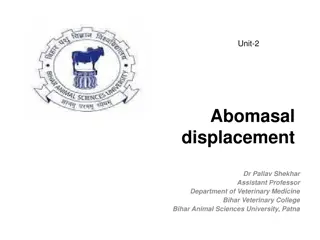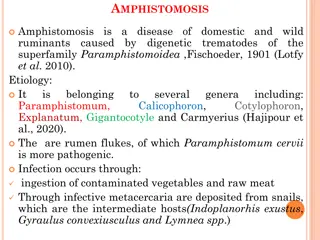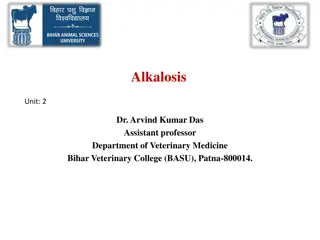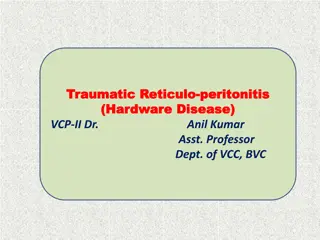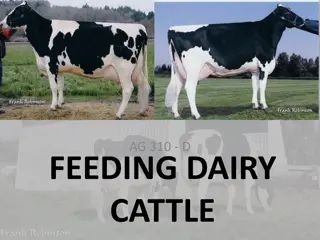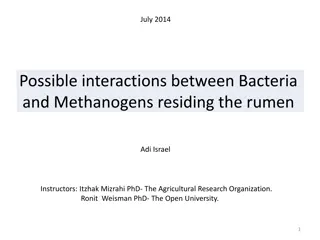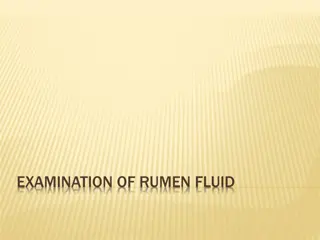Understanding Abomasal Displacement in Dairy Cattle
Abomasal displacement is a common issue in older lactating dairy cattle, often occurring within the first month post-parturition. This displacement, specifically left-sided displacement (LDA), is associated with high concentrate diets, rumen atony, and gas distension. Recognizing the signs and cause
6 views • 21 slides
Understanding Amphistomosis in Ruminants: Causes, Symptoms, and Diagnosis
Amphistomosis is a disease in ruminants caused by several types of rumen flukes. It leads to productivity losses, weight loss, fertility reduction, and other symptoms. Infection occurs through ingestion of contaminated vegetables and raw meat. The parasite affects the rumen and reticulum of sheep, g
0 views • 8 slides
Understanding Alkalosis in Cattle: Causes and Pathophysiology
Alkalosis in cattle, particularly ruminal alkalosis, can be caused by issues such as abomasal atony and alkaline indigestion. Excessive intake of protein-rich feed and changes in diet play a significant role. Pathophysiology involves the accumulation of ruminal ammonia, leading to alkaline pH and ru
1 views • 13 slides
Understanding Vagal Indigestion in Ruminants: Causes and Types
Vagal indigestion in ruminants is a functional disturbance affecting the fore stomachs, leading to symptoms like rumen distention, inappetence, bradycardia, and more. It is not a specific disease but a syndrome with various underlying causes such as injury, inflammation, or mechanical obstruction. T
1 views • 14 slides
Understanding the Digestive System of Ruminant Animals
Ruminant animals have a unique digestive system that allows them to efficiently digest cellulose. Their stomach consists of four chambers, each serving a specific function in the digestion process. The breakdown of cellulose by microbes in the rumen produces glucose, which provides energy for the an
0 views • 22 slides
Carbohydrate Digestion and Metabolism in Ruminants and Non-Ruminants
Digestion and absorption of carbohydrates play a crucial role in the overall metabolism of ruminants and non-ruminants. This process involves various enzymes like amylase, maltase, lactase, and sucrase that break down complex carbohydrates into simpler forms for absorption in the small intestine. Ru
0 views • 17 slides
Traumatic Reticuloperitonitis (Hardware Disease) in Cattle: Causes and Clinical Signs
Traumatic reticuloperitonitis, also known as Hardware Disease, is a common condition in cattle caused by the ingestion of foreign objects. This article discusses its etiology, pathogenesis, and clinical findings such as sudden onset of rumino-reticular atony and decreased milk production. Perforatio
0 views • 10 slides
Understanding Dairy Cattle Feeding: Terms, Nutritional Areas, and Advantages
Learn about important terms like hay, silage, and pre-mix, nutritional areas to balance in a dairy ration, advantages of pastures for feed, and disadvantages to consider. Discover how feeding hay can provide cost-effective nutrients and support proper digestion and rumen function.
0 views • 34 slides
Interactions Between Bacteria and Methanogens in the Rumen
The rumen, an anaerobic fermentation chamber in ruminant animals, houses a diverse microbial community including bacteria, fungi, protozoa, methanogenic archaea, and phages. Methanogens play a crucial role in methane production using fermentation end products. Research aims to explore evidence of in
0 views • 21 slides
Examination of Rumen Fluid and Methods of Collection
The examination of rumen fluid is crucial for diagnosing rumen diseases and for therapeutic purposes like transfaunation. Various physical and chemical characteristics are analyzed, including color, consistency, pH levels, and sedimentation activity. Abnormal findings indicate different health issue
0 views • 17 slides
Study on Long-Term Prevention of Bovine Hardware Disease in Buffaloes
Buffaloes play a significant role in livestock agriculture, but foreign body syndrome poses a threat globally. This study aims to evaluate the efficacy of using rumen magnets as a long-term preventive measure against hardware disease in buffaloes. The incidence of the disease is high in developing c
0 views • 25 slides
